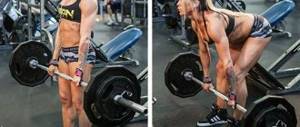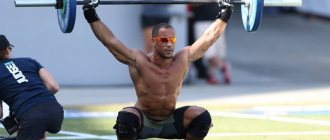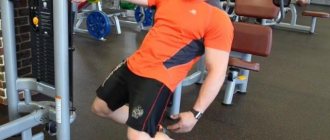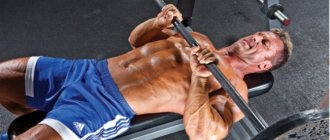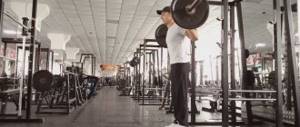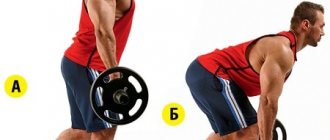Squats, although not the most favorite exercise of many men in the gym, are undoubtedly the most effective for building a beautiful and strong body!
- Do you want to gain muscle mass? - Squat! The leg muscles account for 50% of the total body weight.
- Do you want to enlarge your chest? - Squat! Squats are considered the most effective way to expand the chest.
- Do you want big hands after all? - Squat! Squats are the best way to trigger testosterone release. This is a male sex hormone that is responsible for the growth of muscles throughout the body.
Well? Have we convinced you to start doing squats? Then let's figure out how to squat correctly.
General technique for performing barbell squats
Initial position:
- The bar is located at the back of the neck, on the top of the trapezius.
- Hands slightly wider than shoulders (5-10 cm from each shoulder), firmly grasp the bar.
- The chest is flat, the shoulder blades are slightly brought together, the lower back is tense.
- Feet shoulder-width apart, toes slightly turned outward. The center of gravity of the feet is slightly shifted to the heels.
Performance:
- Taking a short breath, slowly lower yourself down. We continue to keep the lower back straight and tense.
- Having reached the lower position (hips parallel to the floor), we powerfully stand up, exhaling.
Despite all its apparent simplicity, the correct squatting technique has many nuances. We have described the average technique. Now let’s look at the features of performing squats in different sports.
Rack
In a builder squat, the stance is usually shoulder-width apart or slightly wider, with the feet parallel or slightly turned toes out. The goal is to develop quadriceps, not maximal lifting weight.
In lifting, there is often a wider stance (the feet are also slightly turned with their toes outward). This allows you to use more of your pelvic girdle muscles and lift with more weight. But while you may see many powerlifters with a low bar position and a wide stance, this is not the rule for everyone.
Your stance should be determined by your body type and hip mobility. Some athletes set records in the squat and narrow stance.
Squat technique for bodybuilders
The squat technique in bodybuilding is the same as described above. But the depth of the squat differs significantly from other sports.
In bodybuilding, it is customary to lower yourself down to a right angle at the knee joints. The result is a movement of half the possible amplitude. If we use scientific terminology to describe exercises, then these are half squats!
And squats are considered a full range of exercise technique!
This is why powerlifters and weightlifters are lenient when it comes to bodybuilder squats.
But in bodybuilding they don’t pay attention to this nuance. And they continue to use the term - squats.
Squats with weights in bodybuilding are used to pump the front of the thigh (quadriceps). At the same time, they try to exclude the lower back and gluteal muscles from the work as much as possible. They still work though. In order to load other parts of the thighs (inner, outer, back), bodybuilders use many additional exercises.
Squat Technique for Powerlifters
In powerlifting, the goal is to squat the heaviest possible weight. Therefore, the technique of performing squats is significantly different.
In the initial position, the bar is located behind the head, but 5-6 centimeters lower than is customary in bodybuilding. Somewhere on the middle part of the trapezius. This feature of the bar arrangement improves the levers of movement. This allows you to lift much heavier weights.
Another significant difference is the width of the stand. As a rule, in powerlifting, the feet are placed wider than the shoulders. In this case, the toes of the feet turn outward more. During the downward movement, the pelvis is pulled back as much as possible. And the center of gravity is shifted to the heels. The depth of the gray is below parallel.
All these nuances in technique are designed to improve the biomechanics of movement. In this case, the maximum number of muscle groups is involved. In addition to the quadriceps, the lower back, glutes and inner thighs are included.
Squat technique in powerlifting
The correct technique of squats in powerlifting is the foundation on which all other achievements of the athlete are built and the guarantee of the absence of injuries, due to which one can forever forget about practicing not only powerlifting, but also sports in general. This exercise should be taken very seriously and approach the study of the correct squat technique with all rigor and responsibility.
So, the squat is a basic, multi-joint exercise that involves many large and small muscles. The main load falls on the muscles of the lower body. The squat is the first of three competitive lifts in powerlifting.
The squat technique in powerlifting can be divided into three main phases:
- Removing the bar from the racks - taking the starting position
- The squat and lift itself, followed by taking the starting position
- Returning the boom to the racks
Now we will analyze each of the phases in more detail.
In the first phase
it is necessary to remove the barbell from the racks, fixing the barbell on the back. The barbell should be on the top of the trapezius muscle, but not too low. You need to take a stable position, your feet should be shoulder-width apart or slightly wider. With a wide stance, you will gain 1-2 cm in the trajectory of movement, but the load on the ligaments will sharply increase. Toes should be slightly turned outward.
In the second phase
it is necessary to squat with the barbell to a level where the axis of rotation of the hip joint is lower than the axis of rotation of the knee joint. The movement should occur as if you were sitting on a chair, that is, you must first move your pelvis back and then bend your legs at the knee joints. In the initial stages, it will be very useful to practice the correct technique by squatting with a barbell while sitting on a bench. The main center of gravity must be transferred to the heels, and make sure that the knees do not go beyond the plane of the toes. After you have reached the required squat depth, use the strength of your leg and gluteal muscles to return to the starting position.
In the third phase
it is necessary to return the bar to the rack, but keep your back muscles tense, especially the lumbar region, in order to avoid possible injuries.
Also, to achieve the correct squat technique in powerlifting, it is necessary to avoid basic mistakes when performing the exercise
:
- The barbell is too high on the trapezoid. Because of this, an additional lever will be created, deviating your body from the optimal trajectory.
- The grip on the bar is too wide or too narrow. With a grip that is too wide, control over the barbell deteriorates, and with a narrow grip, the load on the elbow joints increases.
- Extra steps when lifting the barbell from the racks. This wastes the energy needed to lift the barbell.
- Excessive head tilt back or forward. Always look straight ahead, this will make your back straighter, which will improve your squatting technique.
- Excessive body tilt forward. May occur due to lack of flexibility or strength in the lower back muscles.
- Quickly lower and jerk from the bottom point. The likelihood of serious injury increases significantly.
- The movement begins by bending your knees. When you go down, your hips should lead, not your knees. The key point of the technique is that the movement begins with a bend in the hip joints, before bending the knees.
- Bringing the knees inward during the lifting phase. This occurs due to an imbalance of forces between the abductor and adductor muscles of the hip.
- Insufficient squat depth
By taking the above recommendations into practice, you will not only significantly improve your squatting technique, but also significantly increase the working weights in this exercise. And also reduce the likelihood of injury to a minimum.
Training video of powerlifting squat technique:
Source: https://bodypumping.ru
Squat technique for weightlifters
In weightlifting, the main distinguishing feature of the squat is the “knee squat.” This is when the knees go forward beyond the line of the toes.
This technique is taboo in bodybuilding and powerlifting. It is believed, and quite reasonably, that knee squats put excessive stress on the knee joints. And this leads to frequent injuries.
Weightlifters' competitive exercises are the snatch and clean and jerk. To lift the barbell above your head, you need to keep your back as straight as possible. Well, this is only possible if you squat on your knees.
So they sacrifice little (their knees) in order to win something bigger - in competitions.
Other types of squats
We looked at the main types of squats with a barbell on the shoulders. Now let's figure out what other squats exist.
- Front squats (or front squats). One of the main auxiliary exercises in weightlifting. It is now unfairly rarely used in bodybuilding. This is due to the uncomfortable position of the bar in the front.
Front squats are great for developing your thigh muscles. At the same time, the load on the spine is minimal.
- Hack squats. They are named after their inventor, Georg Hackenschmidt. Performed with both a kettlebell and a barbell. The weight is held in the lowered hands behind the back.
- Jefferson Squats. Performed with a barbell in lowered hands. The barbell is located between the legs!
- Zercher squats. The bar is located in front, on the bent elbow joints.
All of these types of squats load the leg muscles at unusual angles. It is known that habit is the mother of stagnation. These exercises will be a great way to add variety to your back squats.
Basic mistakes when performing squats
- The main and biggest mistake when doing squats is rounding the back. This usually occurs when rising from a low position. If you cannot keep your back straight, then the weight is too heavy.
Lighten the weight and practice your squat technique until you can keep your back straight. And only then can you GRADUALLY increase the weight on the bar.
In parallel with practicing the squat technique, strengthen the long back muscles (pump up your lower back). Be sure to regularly perform hyperextensions and dips with a barbell on your shoulders. These exercises will quickly and effectively strengthen your lower back.
- The second biggest mistake is squatting to the knees. Unless you're competing in a weightlifting competition, watch your knees!
When squats, your knees should not go beyond the line of your toes!
- Another common mistake is believing in the omnipotence of the weightlifting belt. Many people believe that as soon as you put on a belt, you won’t be afraid of any back injuries. That's what they say - I'll wear a belt so as not to break my back.
Remember! If you have weak lower back muscles and you round your back during squats, no belt will help.
Execution rate
Another factor influencing the results is the speed of movement. For example, you see this indication: 4-1-X-1. The first number indicates the eccentric, or negative, phase (lowering of the projectile), that is, the downward movement lasts 4 seconds. The second number is a pause at the bottom point.
The next symbol describes the concentric phase (rise), the "X" is used to indicate the maximum possible speed. And the last number is a pause at the top point.
If you want more muscles, then at this second contract them further; if your goal is strength, then just take a breath. A few additional comments on each phase.
● Eccentric phase
It is very important for bodybuilders because... significantly stimulates muscle growth. However, for strength athletes, the negative phase can be too “negative” and can lead to an increase in post-workout pain.
This is not a problem if you squat in a bodybuilding program once a week. But for strength athletes who need to train squats 2-4 times a week, constant soreness clearly does not help.
● Pause at the bottom
It can be useful to everyone. Bodybuilders use it to fully stretch working muscles and increase range of motion. Powerlifters linger there to strengthen the movement from the bottom point, eliminating the rebound.
● Concentric phase
In powerlifting, you only need one speed—maximum speed. Of course, when you have a couple of hundredweight on your shoulders, the movement will not look too fast, but you should try to rise faster. Slowing down the concentric or eccentric phase is not as beneficial in powerlifting as it is in bodybuilding.
● Pause at the top point
As I said, bodybuilders should contract their muscles at the top. It helps with hypertrophy and improves neuromuscular communication (brain-muscle connection). It is better for powerlifters to simply rest, saving their strength for high-quality execution of the next repetition.
